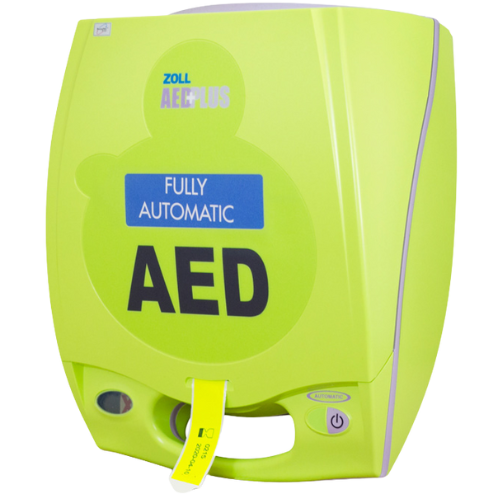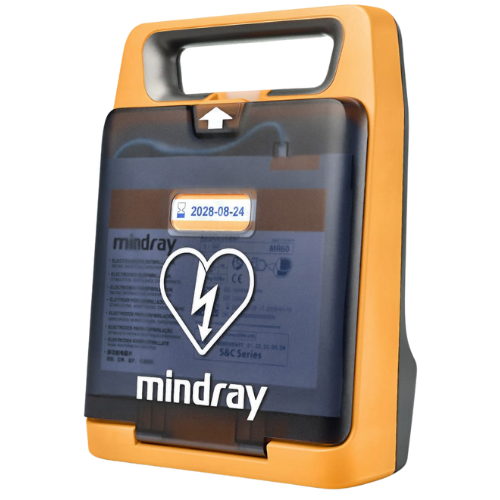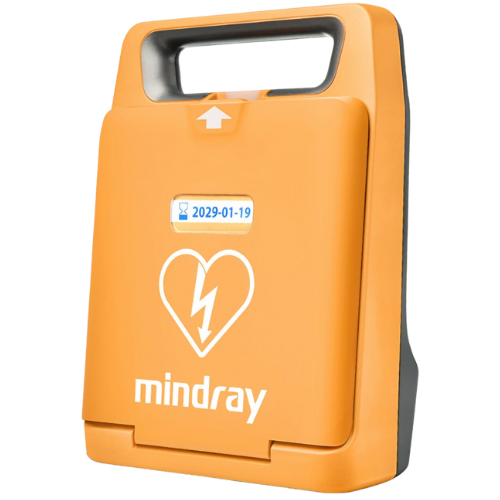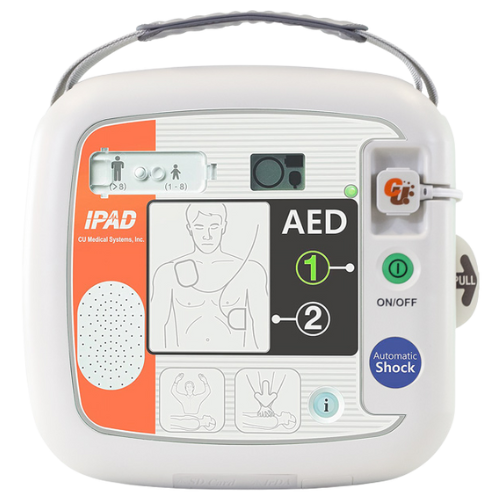Does Your Workplace Need a Defibrillator? UK Legal and Safety Guidance Explained
Every year, thousands of people in the UK suffer sudden cardiac arrest outside hospital. When this happens, time is critical. Each minute without defibrillation reduces the chance of survival. Employers and organisations increasingly consider whether they should provide an automated external defibrillator (AED) on site as part of their first aid provision.
This article explains:
What UK law currently says (and doesn’t say) about defibrillators in the workplace
How to assess whether your premises “need” one
Practical guidance on placement, training and device selection
An example of a modern AED (Mindray C1A) and what features to look for
Did you know?
A modern AED can deliver a shock in under 8 seconds after being turned on (depending on the model), drastically improving chances if used promptly.
What the Law Requires (and Doesn’t) in the UK
In the United Kingdom, there is no legal requirement for employers to have a defibrillator on their premises. However, the Health and Safety (First-Aid) Regulations 1981 require all employers to provide “adequate and appropriate equipment, facilities and personnel” to ensure immediate first aid can be given to employees if they are injured or taken ill at work.
The Health and Safety Executive (HSE) advises that employers should undertake a First Aid Needs Assessment. This determines whether having an automated external defibrillator (AED) is necessary based on several risk factors. These include the size of the workforce, the nature of the work, proximity to emergency medical services, and the likelihood of cardiac incidents occurring on-site.
While not a legal mandate, public and workplace defibrillators are strongly encouraged by organisations such as the Resuscitation Council UK and the British Heart Foundation (BHF). Both emphasise that access to an AED can make the difference between life and death during a sudden cardiac arrest, especially where ambulance response times are longer.
Key Points:
No law compels a workplace to have an AED.
Employers must assess their first aid needs under HSE regulations.
The inclusion of a defibrillator can be deemed “appropriate” based on risk assessment findings.
Having an AED demonstrates a commitment to staff safety and can significantly improve survival outcomes.
Did You Know?
The Resuscitation Council UK notes that survival rates can exceed 70% when an AED is used within 3 minutes of collapse, a figure rarely achievable without a readily available workplace defibrillator.
First Aid Needs Assessment: When a Defibrillator Becomes “Appropriate”
A First Aid Needs Assessment is the process employers use to decide what first aid provisions are necessary for their workplace. The Health and Safety Executive (HSE) recommends including defibrillators in this assessment, especially where cardiac arrest risks are higher or emergency response times are long.
The assessment should consider:
Workforce size and demographics: Larger workplaces, or those with older employees or members of the public on-site, have a higher probability of cardiac events.
Nature of work: Physically demanding or high-stress roles can increase cardiac risk.
Location and ambulance access: Remote or rural sites may experience longer ambulance response times, making an on-site AED more critical.
Public access: Workplaces that welcome visitors or customers (for example, retail, gyms, or community centres) have broader responsibilities under duty-of-care expectations.
When these factors indicate an elevated risk, the inclusion of an AED, such as the Mindray C1A, known for its ease of use and voice-guided prompts, may be deemed “appropriate equipment” under Regulation 3 of the 1981 First-Aid Regulations.
Employers should document the reasoning within their first aid policy. While not legally enforceable, demonstrating a clear, evidence-based assessment aligns with HSE best practice and supports corporate responsibility for health and safety.
Observation:
In many UK workplaces, AEDs are mounted near first aid kits or main entrances, but some remain hidden behind office furniture or poorly signed. Visibility and accessibility are as important as the device itself.
Best Practices for Placement, Access & Signage
Once a defibrillator is installed, its placement and visibility determine how effective it will be in an emergency. Even the most advanced device cannot save lives if staff cannot find it quickly.
Placement
The Resuscitation Council UK and British Heart Foundation (BHF) advise that defibrillators should be:
Clearly visible and unobstructed, ideally mounted on a wall in a central location.
Accessible within three minutes of any part of the building, every minute without defibrillation reduces survival chances by around 10%.
Near first aid stations, reception areas, or staff gathering points.
Stored in a clearly marked cabinet (heated if outdoors) to protect against damage and weather.
In larger workplaces, multiple devices may be necessary. A simple rule is that no one should have to travel more than 90 seconds to reach the AED and return to the casualty.
Access
AEDs should be available to everyone, not just trained personnel.
Modern models, such as the Mindray C1A, use voice and visual instructions to guide even untrained users through each step, from pad placement to shock delivery. This reduces hesitation and ensures faster treatment in critical moments.
Signage
Install standardised AED signage following BS ISO 7010 for emergency equipment. Signs should:
Use the green “AED” heart and lightning bolt symbol.
Be positioned at eye level above the cabinet and along corridors leading to it.
Be illuminated or reflective in low-light areas.
Regular checks ensure the cabinet, pads, and battery remain in date and ready for use.
Did You Know?
Research by the British Heart Foundation found that fewer than 1 in 10 people survive an out-of-hospital cardiac arrest in the UK, but survival doubles when an AED is used before paramedics arrive.
Staff Training, Maintenance & Oversight Obligations
Although automated external defibrillators (AEDs) are designed for public use without formal medical training, the Resuscitation Council UK and HSE both recommend that workplaces provide basic instruction and awareness sessions. This ensures employees know where the device is located and feel confident using it in an emergency.
Training
Training is not legally required, but it significantly improves response times. Recommended actions include:
Annual familiarisation sessions for staff, especially first aiders.
Incorporation into First Aid at Work (FAW) or Emergency First Aid at Work (EFAW) courses.
Simulation exercises to practise locating, retrieving, and activating the AED.
Devices like the Mindray C1A make training simpler because they offer clear voice and visual prompts. Many workplaces also use training defibrillators that replicate the look and function of real units but deliver no electrical shock.
Maintenance
Under the Provision and Use of Work Equipment Regulations 1998 (PUWER), all work equipment must be maintained in a safe condition. While AEDs are low-maintenance, employers should still:
Check status indicators weekly to confirm readiness.
Replace electrode pads and batteries before expiry.
Keep a maintenance log showing inspection dates and replacements.
Register the AED with The Circuit, the national defibrillator network managed by the British Heart Foundation, to ensure emergency services can locate it.
Oversight
Assign a responsible person, often the first aid coordinator, to oversee checks and maintain records. This demonstrates due diligence and ensures compliance with HSE expectations for first aid provision.
Observation:
In many offices, maintenance lapses occur because AED checks are left to untrained staff or are forgotten altogether. Incorporating AED inspection into scheduled health and safety audits helps avoid this oversight.
Choosing a Reliable Device, Example: Mindray C1A
Selecting the right automated external defibrillator (AED) for your workplace depends on usability, reliability, and ongoing support. While all AEDs perform the same essential function, delivering a controlled shock to restart a heart in cardiac arrest, the ease of operation and maintenance features can vary widely.
What to Look For in a Workplace AED
When evaluating options, employers should prioritise devices that are:
Fully automatic – eliminating the need to press a shock button and reducing hesitation.
Equipped with voice and visual prompts – to guide users step by step.
Compact and durable – suitable for varied environments, from offices to factories.
Low-maintenance – with long-life batteries and clear status indicators.
Backed by UK support – ensuring spare parts, pads, and batteries are easily available.
The Mindray C1A: Designed for Accessibility
The Mindray C1A is an example of a modern AED built for public and workplace use. It is a fully automatic defibrillator that delivers a shock without user confirmation once a shockable rhythm is detected. Key features include:
Clear voice instructions and animated guidance, enabling use even by untrained bystanders.
Quick start time, analysis and shock delivery within seconds of pad placement.
CPR feedback prompts, helping rescuers maintain correct compression rate and depth.
Low running costs, with long-life consumables and minimal maintenance needs.
Simple readiness indicator, showing at a glance whether the unit is operational.
These design choices align with HSE recommendations for equipment that is simple, reliable, and suitable for untrained users. For many organisations, the Mindray C1A represents a practical balance between functionality, cost, and compliance with UK safety expectations.
Did You Know?
Mindray devices are used by emergency services and workplaces across Europe, and their C1A model is registered on The Circuit, ensuring visibility to ambulance services during a cardiac arrest call.
Liability, Good Samaritan Protection & Common Law Risk
A common concern among employers and staff is whether using a defibrillator could create legal liability if something goes wrong. In the UK, such fears are largely unfounded. The law recognises that attempting to help in a genuine emergency is an act of good faith, not negligence.
Good Samaritan Principles
While the UK does not have a formal “Good Samaritan Law” like some countries, existing legal principles already provide strong protection. Under common law, anyone who provides assistance in good faith and without gross negligence is very unlikely to be held legally liable.
This approach is supported by the Resuscitation Council UK, which states that there have been no recorded cases of successful legal action against a layperson for attempting resuscitation, including the use of an AED.
Employer Considerations
For employers, providing an AED is viewed as a positive risk reduction measure. Liability is far more likely to arise from failing to take reasonable precautions than from attempting to help. To further minimise risk:
Conduct a First Aid Needs Assessment and document the reasoning for AED installation.
Ensure basic awareness training for staff.
Keep the AED maintained and accessible.
These actions demonstrate compliance with HSE guidance and support the organisation’s duty of care under health and safety legislation.
Data and Privacy
If an AED is used, some devices (including the Mindray C1A) record event data such as heart rhythm and shocks delivered. This information should be handled confidentially and only shared with emergency services or authorised personnel.
Observation:
Many UK businesses now include AEDs within their insurance and health & safety audits, reflecting a growing understanding that proactive measures reduce both health and legal risks.
Case Studies / Real-World Examples
Real-world examples highlight how accessible defibrillators transform emergency outcomes in workplaces and public spaces. These cases also demonstrate how routine preparedness and the right equipment, such as the Mindray C1A, can make the difference between life and death.
Case Study 1: Warehouse Response, West Midlands
In a logistics warehouse employing over 150 staff, a worker suffered sudden cardiac arrest during a night shift. A colleague retrieved the on-site AED, a Mindray C1A, within two minutes. The device’s voice prompts and automatic shock delivery enabled staff to act immediately while waiting for paramedics. The ambulance service later confirmed that the employee’s life was saved by the rapid defibrillation and effective CPR.
The company has since expanded AED coverage to all facilities and now conducts six-monthly refresher sessions.
Case Study 2: Office Building, Manchester
An office complex shared by multiple small businesses installed a communal AED near reception following an HSE risk assessment. Within six months, it was used during a cardiac arrest involving a visiting contractor. The AED was retrieved and deployed before emergency services arrived, and the individual made a full recovery.
Following the incident, building management upgraded signage and registered the AED on The Circuit, allowing ambulance services to direct callers to it during emergencies.
Case Study 3: Manufacturing Site, Kent
A manufacturer chose to rent defibrillators rather than purchase them outright. Their rental package included maintenance, replacement pads, and signage. The Mindray C1A’s durability and long battery life made it well suited for industrial settings with temperature fluctuations. Routine checks and documented inspections ensured compliance with PUWER standards.
Did You Know?
According to the British Heart Foundation, public access defibrillators are used in roughly 10% of out-of-hospital cardiac arrests, yet these cases account for over 40% of survivors, a clear indicator of their impact.
Summary & Key Takeaways
Installing a defibrillator in the workplace is not a legal requirement in the UK, but it is widely recognised as best practice. The Health and Safety (First-Aid) Regulations 1981 require employers to ensure adequate and appropriate first aid provision, and a First Aid Needs Assessment often identifies an AED as part of that provision, especially in larger or higher-risk workplaces.
Key Takeaways:
Legal Status: No law mandates AEDs, but HSE guidance expects employers to assess their need.
Assessment: Consider workforce size, site layout, emergency access, and the likelihood of cardiac events.
Placement: Position AEDs where they are visible, signed, and reachable within three minutes from any location.
Training & Oversight: Regular checks and brief staff awareness sessions ensure readiness and compliance.
Device Selection: Choose models that are simple, reliable, and require minimal maintenance, such as the Mindray C1A, which provides clear instructions and automatic operation.
Liability Protection: UK law supports those acting in good faith; legal risk from using an AED is negligible compared with the moral and reputational risk of inaction.
Installing an AED, or choosing a rental plan that includes maintenance and registration, demonstrates both corporate responsibility and practical readiness. The difference between life and death in cardiac arrest can be measured in minutes, making preparation the single most effective action a workplace can take.
Observation:
In many modern offices, AED cabinets now sit beside fire extinguishers and first aid kits, a visible reminder that safety culture evolves with awareness and accessibility.
FAQs
Do I need a defibrillator in my workplace?
Not by law. However, the Health and Safety Executive (HSE) expects every employer to carry out a First Aid Needs Assessment. If cardiac arrest is a foreseeable risk, due to workforce size, age profile, or location, an AED is considered an appropriate provision.
Can anyone use an AED?
Yes. All modern AEDs, including the Mindray C1A, are designed for use by untrained bystanders. They provide clear voice and visual prompts to guide users safely through every step.
Do staff need defibrillator training?
Training is not legally required, but it helps improve confidence and speed in emergencies. Many workplaces include AED use in their First Aid at Work (FAW) or Emergency First Aid at Work (EFAW) training.
How often should a workplace defibrillator be checked?
Carry out weekly visual checks and record them in a log. Replace pads and batteries before their expiry dates. The Mindray C1A includes a status indicator to show whether the unit is ready for use.
Is there a legal risk in using an AED?
No. Under UK common law, anyone who acts in good faith to help someone in cardiac arrest is protected. There have been no recorded cases of legal action against people using a defibrillator in an emergency.
Sources
Health and Safety Executive (HSE) – First Aid at Work Guidance
https://www.hse.gov.uk/firstaid/what-employers-need-to-do.htm
→ Defines employers’ responsibilities under the Health and Safety (First-Aid) Regulations 1981.Resuscitation Council UK – AED Use and Guidance
https://www.resus.org.uk/library/quality-standards-cpr/aeds-and-defibrillation
→ Explains AED operation, Good Samaritan protection, and workplace recommendations.British Heart Foundation (BHF) – The Circuit and AED Facts
https://www.bhf.org.uk/how-you-can-help/how-to-save-a-life/defibrillators
→ Provides survival statistics, registration information, and advice on community AED access.Mindray – C1A Product Overview
https://www.mindray.com/uk/product/c1a.html
→ Technical specifications, usability features, and workplace suitability for the Mindray C1A defibrillator.Provision and Use of Work Equipment Regulations 1998 (PUWER)
https://www.legislation.gov.uk/uksi/1998/2306/contents/made
→ Outlines employer obligations for safe maintenance of workplace equipment, including AEDs.
Source Commentary:
The HSE provides the regulatory foundation for first aid provision in UK workplaces.
The Resuscitation Council UK supplies expert medical guidance on AED use and user protection.
The BHF contributes national data on cardiac arrest survival and AED registration.
Mindray offers verified product details for the C1A model, ensuring factual device representation.
Legislation.gov.uk confirms maintenance obligations under PUWER regulations.








